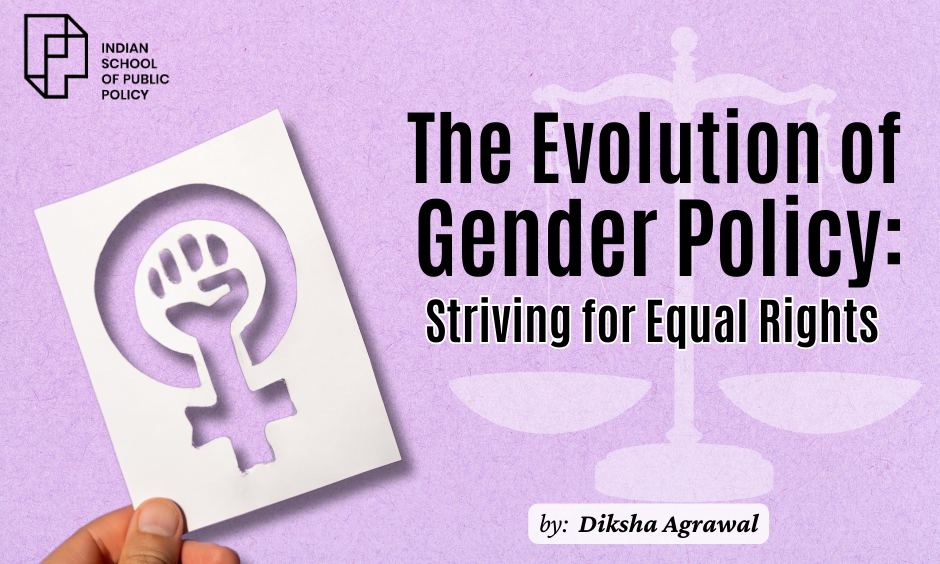
The Evolution of Gender Policy: Striving for Equal Rights

August 19, 2024, was a night that saw a fresh wave of outrage and grief following the brutal rape and murder of a 31-year-old postgraduate resident doctor in Kolkata. Protests erupted across the country against the gruesome act, with the public demanding systemic change in justice delivery.
The horrifying incident is a clear reminder that, as a society, we are yet to ensure women a feeling of safety, both in homes and workplaces. Despite making up half of the population, women often feel threatened by men, afraid to go out alone, and constantly worried about getting home safely. This fear impacts their freedom, affecting their ability to build successful careers. Many protective families prefer women to stay home rather than venture into the public sphere to avoid such dangers. This incident reminds us to revisit and critically analyse the evolution of gender policies in India.
EVOLUTION OF GENDER POLICY IN INDIA
India has had a complex journey towards achieving gender equality, with a profound interplay between cultural traditions, legal reforms, and social movements. Understanding the historical context of gender policy becomes important to grasp both the challenges that still pertain and the progress that has been made. It becomes essential to trace the entire trajectory, from the persistent effort of early social reformers to contemporary legislative and judicial interventions.
Early Social Reform Movements
Early reform movements in India, led by Raja Ram Mohan Roy, Ishwar Chandra Vidyasagar, and Jyotibhai Phule, are significant historical events because they challenged oppressive practices like Sati and child marriage widely prevalent in Indian society. Raja Ram Mohan Roy, often known as the “Father of Modern India” or “Father of Bengal Renaissance,” fought against the inhuman practice of Sati, which was prevalent for centuries, leading to its eventual abolition in 1829. Ishwar Chandra Vidyasagar’s relentless effort to uplift the status of widows and challenge societal norms led to the passage of the Widow Remarriage Act of 1856. He also played a crucial role in advancing women’s education, laying the foundation for a more equitable society, and influencing future generations in their continued struggle for greater equality and rights for women.
Post-Independence Struggle
The post-independence period saw the inclusion of gender equality within the country’s constitutional and legal framework. The preamble of the newly framed Indian constitution called for “equality of status and of opportunity” and incorporated various articles that guaranteed women equality. Let us look at the different articles that guarantee equality for women in all aspects of public life:
- Article 14: Guarantees equality before law
- Article 15: Prohibits discrimination on grounds of sex
- Article 16: Ensures equal opportunity in public employment
- Article 51A: It mandates every citizen to renounce practices derogatory to women’s dignity.
India has also enacted laws to improve women’s status. Let us look at some of the prominent laws that have been significant in shaping the history of women’s rights in the country.
- Dowry Prohibition Act 1961: The Dowry Prohibition Act of 1961 aimed to combat the practice of dowry by prohibiting the demand, payment, and acceptance of dowry and prescribing penalties for both giving and receiving dowry.
- Protection of Women from Domestic Violence Act, 2005: India has a significant gender gap, as evident in global indices. Patriarchy has led to many males having a sense of superiority and entitlement, which has led them to use violence as a means of asserting dominance and entitlement. The Protection of Women from Domestic Violence Act 2005 was formulated to protect women from all forms of violence and abuse: physical, emotional, economic, and sexual. The Act offers legal safeguards and recourse for victims trapped in abusive homes.
- Sexual Harassment of Women at Workplace Act 2013: The Act aims to address the issue of sexual harassment faced by women in the workplace to create a safe and conducive work environment for women.
- Maternity Benefit Act, 1961: This law aims to provide security of tenure for working women. It regulates women’s employment in certain establishments before and after childbirth. The objective is to curb discrimination against women during hiring practices and make workplaces more inclusive.
JUDICIAL PRONOUNCEMENTS
- Randhir Singh vs. Union of India Case: This case reinforced the principle of equal pay for equal work and stated that if everything is equal or all relevant factors are the same, people with identical tasks cannot be treated differently regarding their pay.
- Vishakha vs State of Rajasthan: After the Bhanwari Devi Case, many women groups came to the streets to recognise equal rights as citizens of India and urged the government to take necessary steps to prevent the ill-treatment of women in the workplace. After taking note of such instances of women being exploited in workplaces, the court formulated the Vishakha guidelines. It provided guidelines to prevent sexual harassment of women at workplaces and ensure that people who indulge in such acts are given appropriate punishment.
- Laxmi Vs. Union of India (2015): The Supreme Court placed limitations on the vending of acid and awarded the victims of acid attack compensation. It was in response to a PIL filed by Laksmi, a strong acid attack survivor, against the Union of India, which led to the publication of recommendations for the benefit of acid attack survivors.
Despite legal advancements, societal challenges to combat violence against women persist. Legislation alone is not enough to achieve equality. Social and cultural beliefs need to evolve. Society cannot thrive unless women, who constitute half the human race, are given equal rights in all aspects of life. The journey towards gender equality is ongoing, and continued efforts are needed so that women feel safe in domestic and public realms of life.
Register your Interest to Study at ISPP
References
- Jazeera, A. (2024, August 27). India police fire tear gas at protest against Kolkata doctor’s rape, murder. Al Jazeera. https://www.aljazeera.com/news/2024/8/27/india-police-fire-tear-gas-at-protest-against-kolkata-doctors-rape-murder
- Women’s empowerment in India, from ancient period to modern time period. (2022, November 16). Times of India Blog. https://timesofindia.indiatimes.com/readersblog/scatteredthoughts/womens-empowerment-in-india-from-ancient-period-to-modern-time-period-46689/
- Mahawar, S. (2023, August 19). Gender equality and the Indian Constitution – iPleaders. iPleaders. https://blog.ipleaders.in/gender-equality-and-the-indian-constitution/
- Case Analysis- Vishaka and others v/s State of Rajasthan. (n.d.). https://www.legalserviceindia.com/legal/article-374-case-analysis-vishaka-and-others-v-s-state-of-rajasthan.html#google_vignette

Diksha Agrawal
Programme Advisor – Admissions
Diksha Agrawal, a Sociology graduate from Miranda House and postgraduate from Delhi School of Economics, embarked on her professional journey as a research fellow for Prashant Kishore’s Jan Suraaj initiative. Travelling across various districts of Bihar, she gained profound insights into the diverse needs of communities, igniting a deep interest in the field of public policy.
Furthering her engagement in politics and governance, Diksha served as a consultant for Inclusive Minds, political consultancy working for Indian National Congress during the Chhattisgarh elections. This role provided her with invaluable insights into the socio-political landscape of the state, reinforcing her determination to drive positive change through effective policy formulation and implementation.


